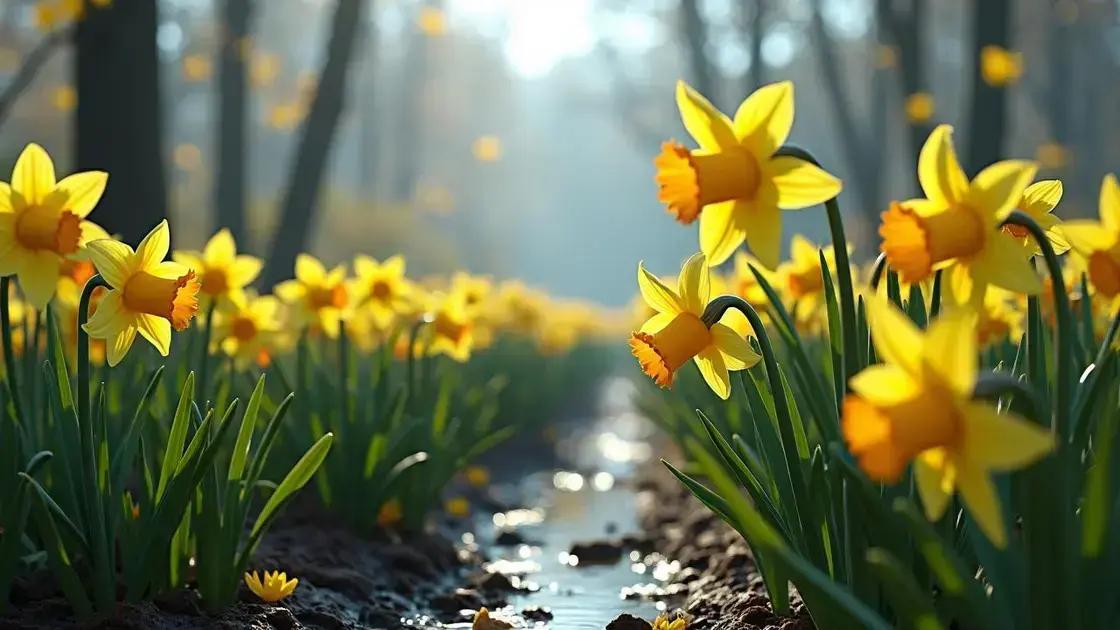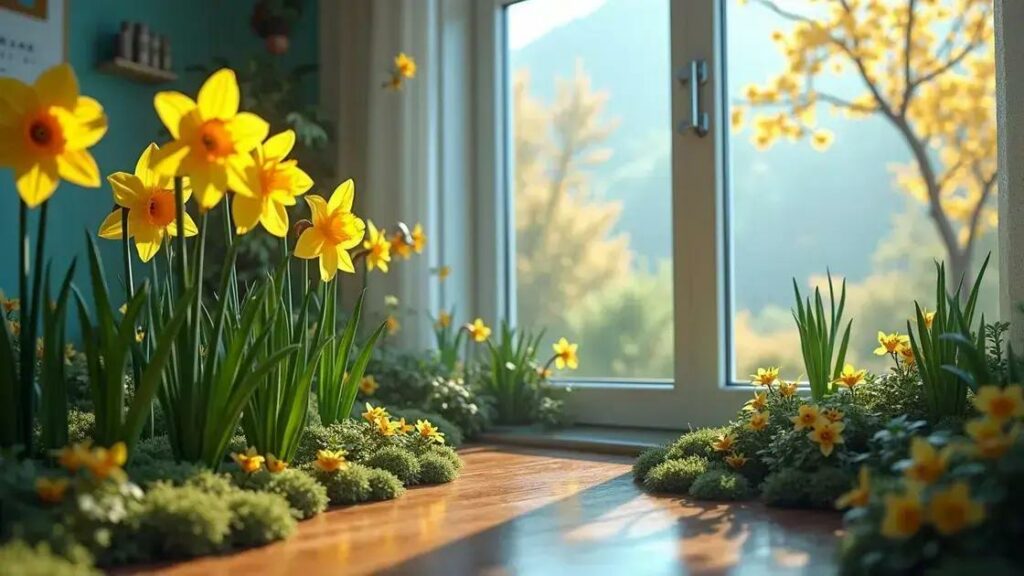How to care for a daffodil plant indoors is a question many indoor gardening enthusiasts ask themselves. With their bright and cheerful blooms, daffodils can bring a splash of color and joy to any indoor space. However, proper care is crucial to keep them thriving. In this guide, you’ll discover some indispensable tips to help your daffodils flourish indoors, ensuring they become a beautiful addition to your home.
Table of Contents
ToggleUnderstanding the light requirements for daffodils indoors
Understanding the light requirements for daffodils indoors is essential for their growth and vibrant blooms. Daffodils thrive best when they receive the proper amount of light, which can significantly impact their overall health. Here are key points to consider for lighting your indoor daffodil plants:
- Direct sunlight access: Daffodils prefer bright, direct sunlight for at least 6 hours a day. A south- or west-facing window is ideal.
- Artificial lighting options: If natural light is insufficient, consider using grow lights. These can effectively supplement sunlight and provide the necessary spectrum for healthy growth.
- Seasonal adjustments: During the shorter days of winter, you may need to adjust the lighting schedule for your daffodils to ensure they get enough light.
This ensures your daffodils receive the right amount of light exposure to flourish. Make sure to observe your plants and adjust their placement if they appear leggy or are not blooming as expected.
Types of light conditions
Daffodils will respond differently to various light conditions. Here’s a breakdown:
| Light Condition | Effect on Daffodils |
|---|---|
| Full sunlight (6+ hours) | Optimal growth with vibrant blooms. |
| Partial shade (3-5 hours) | Growth may be slower, fewer blooms. |
| Low light (<3 hours) | Stunted growth and almost no blooming. |
By being mindful of these conditions, you can provide the best environment for your indoor daffodils. Additionally, remember to rotate your pots every couple of weeks to ensure even light exposure on all sides.
For further insights into keeping indoor plants healthy, consider exploring indoor gardening techniques that can benefit your entire indoor garden.
Essential watering techniques for daffodil plant health

Essential watering techniques for daffodil plant health are vital for ensuring the longevity and vibrancy of your indoor daffodils. Proper watering habits not only promote healthy root development but also enhance blooming. Here are important techniques to consider:
- Watering frequency: Water your daffodils when the top inch of soil feels dry. Typically, this is every 7 to 10 days, but it can vary based on climate.
- Watering method: Use a watering can with a spout for precision. Pour water directly onto the soil, avoiding the leaves to prevent rot.
- Drainage consideration: Ensure pots have drainage holes to prevent waterlogging, which can lead to bulb rot.
Signs of overwatering and underwatering
Recognizing the signs of both overwatering and underwatering is crucial for maintaining the health of your daffodils:
| Condition | Signs |
|---|---|
| Overwatering | Yellowing leaves, wilting despite moist soil, and possible mold. |
| Underwatering | Wrinkled bulbs, dry leaves, and drooping flowers. |
Adjust your watering strategy based on the observed conditions to bring your daffodils back to health. It’s an ongoing process that often requires keen observation.
Water quality
Using the right type of water can also impact your daffodils:
- Tap water: Often contains chlorine or fluoride; letting it sit for 24 hours can help.
- Rainwater: A natural choice, typically free of chemicals, making it ideal for indoor plants.
It’s essential to continually refine your approach to watering as you learn the specific needs of your daffodils.
For more guidance on keeping your indoor plants healthy, consider exploring indoor gardening techniques that can benefit your entire indoor garden.
Choosing the best soil for your indoor daffodil bulbs
Choosing the best soil for your indoor daffodil bulbs is essential to promoting healthy growth and vibrant blooms. The right soil provides necessary nutrients, supports root development, and maintains proper moisture levels. Here’s what you need to know about selecting soil for your daffodils:
- Soil type: Aim for well-draining potting mix that retains moisture without becoming soggy. A mix formulated for bulbs or flowering plants is ideal.
- pH level: Daffodils prefer a slightly acidic to neutral pH, ideally between 6.0 and 7.0. You can test your soil with a simple pH kit.
- Nutrient content: Enriched soil with organic matter, such as compost, will provide your daffodils with the nutrients they need to thrive.
Tips for enhancing soil quality
Improving the quality of your soil can contribute to healthier daffodil plants. Here are some techniques:
- Mix in perlite or vermiculite to enhance drainage and aeration.
- Incorporate slow-release fertilizers to provide a steady source of nutrients.
- Regularly refresh the top layer of soil to maintain nutrient levels and improve texture.
Soil comparison table
Here’s a quick comparison of common soil types used for indoor daffodils:
| Soil Type | Benefits | Considerations |
|---|---|---|
| Potting Mix | Well-draining, nutrient-rich | Can retain too much moisture if not designed for bulbs |
| Compost Blend | High in organic matter, improves soil structure | May require additional drainage materials |
| Custom Bulb Mix | Tailored for bulb growth, great drainage | Can be harder to find compared to general mixes |
By considering these factors, you can ensure your daffodils have the best possible environment to grow.
If you’re looking to enhance your indoor gardening skills further, consider exploring indoor gardening techniques that offer valuable tips for all types of indoor plants.
In conclusion
Caring for your indoor daffodil plants is a rewarding journey that combines understanding their light, watering, and soil needs. By implementing the essential tips we’ve discussed—ensuring adequate light, mastering proper watering techniques, and selecting the best soil—you’ll be well on your way to enjoying beautiful blooms.
As you nurture your daffodils, continue to explore resources and connect with fellow indoor gardening enthusiasts. For additional advice and community support, check out tips on enhancing your indoor garden. Happy gardening!

